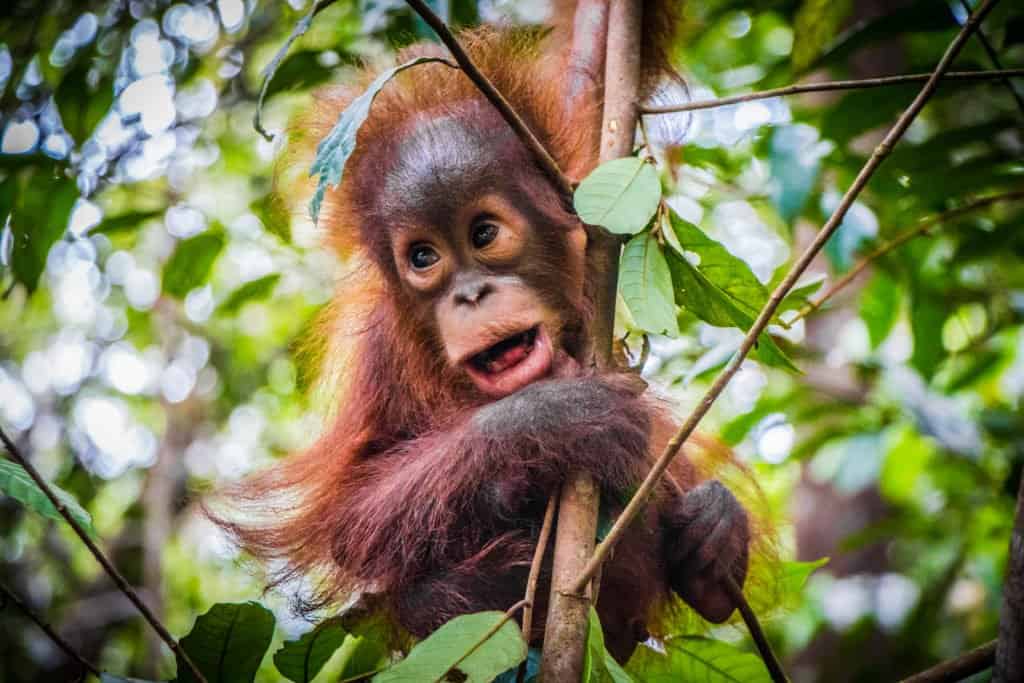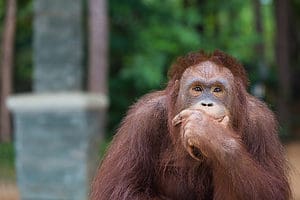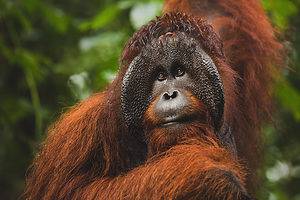Orangutans are a group of great ape species native to Indonesian and Malaysian rainforests. Until approximately 10,000 years ago, they enjoyed a wider range throughout China and Southeast Asia. Today, they can only be found on the islands of Borneo and Sumatra. Their common name has nothing to do with their orange coloring, as one may assume. Instead, it is a compound Malay word that roughly translates to “person of the forest.”
There are three closely-related species of orangutan: the Sumatran orangutan (P. abelii), the Bornean orangutan (P. pygmaeus), and the Tapanuli orangutan (P. tapanuliensis). With orangutan populations separated from each other on different islands, slight differences formed in each species due to environmental factors. Let’s dive into what orangutans eat and how this compares to other great apes!
The Orangutan Diet: What Do Organutans Eat?

Orangutans eat an omnivorous diet consisting of fruit, foliage, eggs, insects, and small animals. They are also known to consume soil on occasion, a phenomenon known as geophagy. Certain compounds in soil are thought to counteract some of the toxic and acidic foods that the apes consume.
Fruit makes up over half of an orangutan’s diet—they enjoy fleshy, soft fruits, especially those that pop up in large crops on their respective trees. Figs, berries, and drupes also make up a large part of their diet, more so when their primary fruits are out of season. They act as a seed disperser for many of these fruit species, and may be the only known animal that helps spread the slightly-toxic aguwason plant.
Another big part of their diet is plant leaves—they are known to consume over 400 different species of foliage! When fruit is less abundant, they may rely more heavily on leaves and bark. A large portion of their day may be spent gathering and munching on leaves.
As they flow through the trees, orangutans are happy to snack on bird eggs when they stumble upon them. Although a rare occurence, they have been observed eating small creatures, such as lizards, slow loris, and rodents. This behavior is usually reserved for times when fruit becomes less abundant.
Orangutans tend to split up their foraging times throughout the day. They may begin the day with 2 to 3 hours of eating before taking a midday nap. Once rested, they will travel and forage again until its time to bed down and craft their nests. Orangutans spend an estimated 4 to 6 hours foraging and eating each day.

A group of young orangutans.
©tristan tan/Shutterstock.com
Organutans Compred to Other Great Apes
Orangutans are the most arboreal of the great apes and live most of their lives in the trees. They travel and forage through the forest canopy for most of their day, and they even make their nests in elevated locations. Intricate nest-building is a unique characteristic of orangutans. They often add pillows, roofs, and blankets to their “beds.”
The apes have long, gangly arms in comparison to their height. The average male only stands around 4.5 feet tall, but may have an arm span of over 6 feet. Orangutans exhibit an extreme case of sexual dimorphism, as males are approximately twice as large as females. The average male weighs 165 pounds, while females weigh an average of 82 pounds.
Orangutans are critically endangered and often serve as the face of conservation movements around the world. Deforestation and human encroachment continues to wipe out orangutan habitats. Current populations sit at around 50,000 individuals—this is estimated to be only 25% of the population that existed just a century ago.
What Do Orangutans Drink?
Orangutans receive most of their water from the succulent fruits that they consume. They also gather moisture that collects on leaves and from recesses in trees. When supplemental water is needed, they will descend from the trees to drink from streams and rivers. Baby orangutans sometimes drink water from their mother’s mouth.
Do Orangutans Have Any Predators?

A baby orangutan learns to climb.
©Alex East/Shutterstock.com
Orangutans are near the top of the food chain in their ecosystem, but they do have a few natural predators, including the Sumatran tiger and the clouded leopard. These big cats are nocturnal and can make easy prey of sleeping orangutans, especially the smaller ones. Borneo orangutans have no threat of tigers, allowing them to live more of their life on the ground.
Unfortunately, humans pose the biggest threat to orangutans. Poaching is common—in addition to gathering meat, hunters will also attack orangutans that intrude on their property.
The World Wildlife Foundation has sponsored programs to help bridge the gap between humans and orangutans. They started honey farms along the edges of forests to provide income to surrounding communities without the need for deforestation. Many national parks have been established throughout Indonesia and Borneo in order to protect orangutans and their habitats.
The photo featured at the top of this post is © Svetlana Orusova/Shutterstock.com
FAQs (Frequently Asked Questions)
Are Orangutans Dangerous?
Orangutans are generally not aggressive, although they are extremely strong for their size and may defend themselves if they feel threatened. Males will often compete for territory or females. Attacks on humans are practically non-existent and only occur when the apes are provoked.
How Long Do Orangutans Live?
The lifespan of an orangutan in the wild is around 35 to 40 years. Captive orangutans may live for 50 or more years with the proper care.
Orangutans reach sexual maturity around 8 years of age, but they may stick around with their mother for many more years. They have the longest childhood dependence out of any animal in the world (rivaled only by humans, which have double the lifespan). Males may “leave home” around 10 to 12 years, but females may stay even longer to learn the intricacies of motherhood. Orangutans give birth approximately every 7 to 8 years, which is the longest time between births for any mammal. For this reason, populations are slow to recover when they come under threat.
Thank you for reading! Have some feedback for us? Contact the AZ Animals editorial team.







